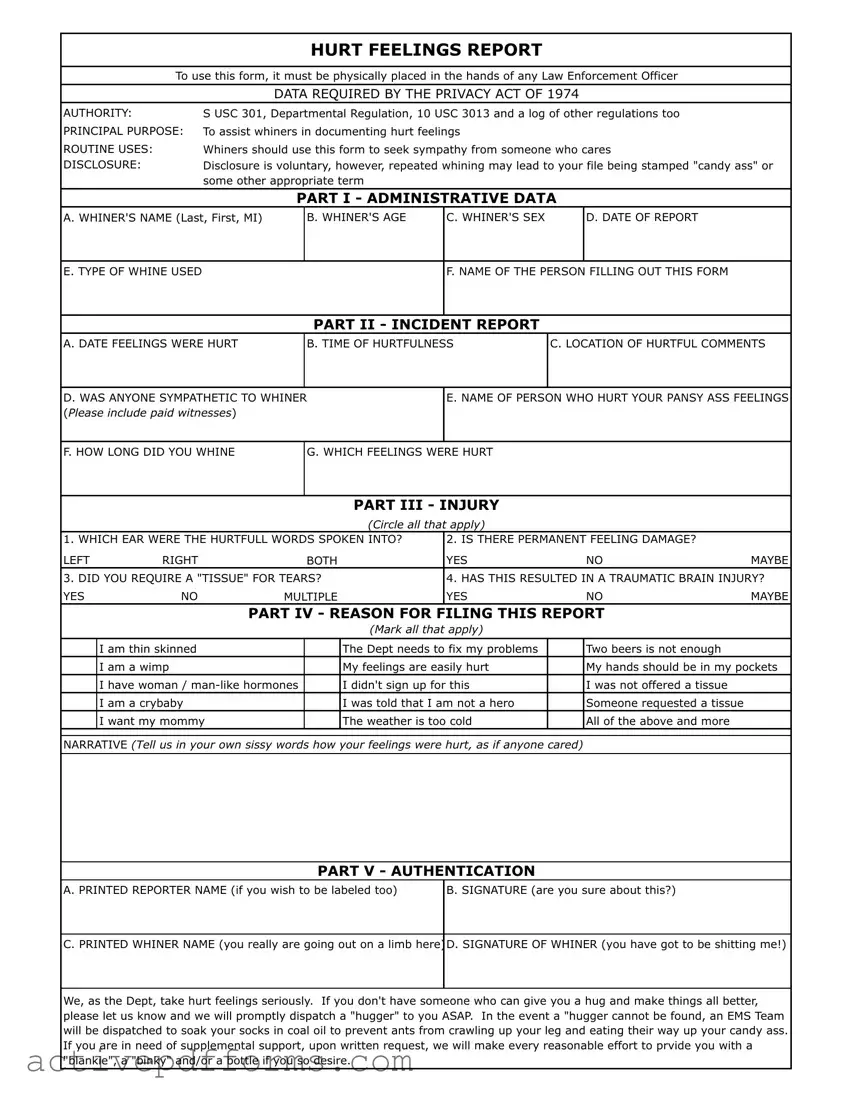HURT FEELINGS REPORT
For use of this form, see FM 22-102; the proponent agency is TRADOC
DATA REQUIRED BY THE PRIVACY ACT OF 1974
AUTHORITY: 5 USC 301, Departmental Regulations; 10 USC 3013, Secretary of the Army and E.O. 9397 (SSN)
PRINCIPAL PURPOSE: To assist whiners in documenting hurt feelings, and to provide leaders with a list of soldiers who require additional counseling, NCO leadership, and extra duty..
ROUTINE USES: For subordinate leader development IAW FM 22-102. Leaders & whiners should use this form as necessary.
DISCLOSURE: Disclosure is voluntary, but repeated disclosure may result in a DA Form 779-1A, Report of Wall To Wall Counseling
PART I – ADMINISTRATIVE DATA
A. WHINER’S NAME (Last, First, MI)
C. SOCIAL SECURITY NUMBER
F. NAME & TITLE OF THE PERSON FILLING OUT THIS FORM
PART II – INCIDENT REPORT
A. DATE FEELINGS WERE HURT |
|
B. TIME OF HURTFULNESS |
C. LOCATION OF HURTFUL INCIDENT |
|
D. NCO OR OFFICER SYMPATHETIC TO WHINER |
|
|
|
|
|
|
E. NAME OF REAL MAN/WOMAN WHO HURT YOUR SENSITIVE |
F. RANK/GRADE |
|
G. ORGANIZATION (if different from 1e above) |
FEELINGS |
|
|
|
|
|
|
|
|
|
|
|
|
|
|
|
|
|
|
|
|
E. INJURY (Mark all that apply) |
|
|
|
|
1. WHICH EAR WERE THE WORDS OF HURTFULNESS SPOKEN INTO? |
|
2. IS THERE PERMANENT FEELING DAMAGE? |
|
LEFT |
RIGHT BOTH |
|
|
YES |
NO |
MAYBE |
|
|
|
3. DID YOU REQUIRE A “TISSUE” FOR TEARS? |
|
4. HAS THIS RESULTED IN A TRAUMATIC BRAIN INJURY? |
YES NO MULTIPLE ________ |
|
|
YES |
NO |
MAYBE |
|
|
|
|
|
|
|
|
|
F. REASON FOR FILING THIS REPORT (Mark all that apply)
I am thin skinned
I am a wimp
Ihave woman/man‐like hormones
Iam a crybaby
Iwant my mommy
The Army needs to fix my problems
My feelings are easily hurt
I didn't sign up for this
I was told that I am not a hero
The weather is to cold
Two beers is not enough
My hands should be in my pockets
I was not offered a post brief
Someone requested a post brief
All of the above and more
G. NARRATIVE (Tell us in your own sissy words how your feelings were hurt.)
PART III ‐ AUTHENTICATION
a. PRINTED NAME OF REAL MAN/WOMAN
c. PRINTED NAME OF WHINER
We, as the Army, take hurt feelings seriously. If you don't have someone who can give you a hug and make things all better, please let us know and we will promptly dispatch a "hugger" to you ASAP. In the event we are unable to find a "hugger" we will notify the fire department and request that they send fire personnel to your location. If you are in need of supplemental support, upon written request, we will make every reasonable effort to provide you with a "blankey", a "binky" and/or a bottle if you so desire.
DA FORM IMT WF1, APRIL 2009 |
EDITION OF APRIL 1989 IS OBSELETE |

